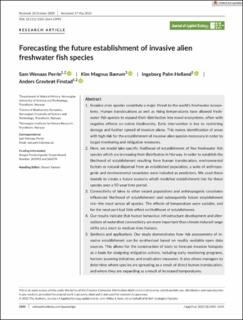| dc.contributor.author | Perrin, Sam | |
| dc.contributor.author | Bærum, Kim Magnus | |
| dc.contributor.author | Helland, Ingeborg Palm | |
| dc.contributor.author | Finstad, Anders Gravbrøt | |
| dc.date.accessioned | 2022-02-25T07:54:13Z | |
| dc.date.available | 2022-02-25T07:54:13Z | |
| dc.date.created | 2021-09-24T15:27:33Z | |
| dc.date.issued | 2021 | |
| dc.identifier.citation | Journal of Applied Ecology. 2021, 58 (11), 2404-2414. | en_US |
| dc.identifier.issn | 0021-8901 | |
| dc.identifier.uri | https://hdl.handle.net/11250/2981355 | |
| dc.description.abstract | 1. Invasive alien species constitute a major threat to the world’s freshwater ecosystems. Human translocations as well as rising temperatures have allowed freshwater fish species to expand their distribution into novel ecosystems, often with negative effects on native biodiversity. Early intervention is key to restricting damage and further spread of invasive aliens. This makes identification of areas with high risk for the establishment of invasive alien species necessary in order to target monitoring and mitigation measures. 2. Here, we model lake-specific likelihood of establishment of five freshwater fish species which are increasing their distribution in Norway. In order to establish the likelihood of establishment resulting from human translocation, environmental factors or natural dispersal from an established population, a suite of anthropogenic and environmental covariates were included as predictors. We used these models to create a future scenario which modelled establishment risk for these species over a 50 year time period.3. Connectivity of lakes to other extant populations and anthropogenic covariates influenced likelihood of establishment - and subsequently future establishment risk - the most across all species. The effects of temperature were variable, and for the most part had little effect on likelihood of establishment. 4. Our results indicate that human behavior, infrastructure development and alternations of watershed connectivity are more important than climate induced range shifts on a short to medium time horizon. 5. Synthesis and applications: Our study demonstrates how risk assessments of invasive establishment can be synthesised based on readily available open data sources. This allows for the construction of tools to forecast invasion hotspots as a basis for designing mitigation actions, including early monitoring programs, horizon scanning initiatives and eradication measures. It also allows managers to determine where species are spreading as a result of direct human translocation, and where they are expanding as a result of increased temperatures. | en_US |
| dc.language.iso | eng | en_US |
| dc.publisher | John Wiley & Sons Ltd. | en_US |
| dc.rights | Navngivelse-Ikkekommersiell 4.0 Internasjonal | * |
| dc.rights.uri | http://creativecommons.org/licenses/by-nc/4.0/deed.no | * |
| dc.title | Forecasting the future establishment of invasive alien freshwater fish species | en_US |
| dc.type | Peer reviewed | en_US |
| dc.type | Journal article | en_US |
| dc.description.version | publishedVersion | en_US |
| dc.source.pagenumber | 2404-2414 | en_US |
| dc.source.volume | 58 | en_US |
| dc.source.journal | Journal of Applied Ecology | en_US |
| dc.source.issue | 11 | en_US |
| dc.identifier.doi | 10.1111/1365-2664.13993 | |
| dc.identifier.cristin | 1938359 | |
| dc.relation.project | Norges forskningsråd: 243910 | en_US |
| dc.relation.project | Norges forskningsråd: 266574 | en_US |
| cristin.ispublished | true | |
| cristin.fulltext | original | |
| cristin.qualitycode | 2 | |

